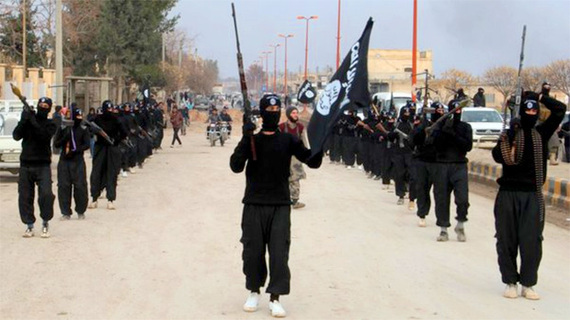The Evolution of Sunni Insurgency
Talk by Luay al-Khatteeb at Al Khoei Foundation, CASS, 1 July 2016
The 2003 regime change in Iraq ignited a different type of militancy in the Middle East. This involved state actors who opposed the Shia domination in Iraq. It started with the emergence of Ba'athist holdouts, including members of the Republican Guard and Fedayeen Saddam -- the latter group having been formed to fend-off a second uprising but ended up becoming an insurgent group. Many of these groups then formed an alliance with al-Qaeda in Iraq (2004) and other groups such as non-Baathist nationalists and Salafist-jihadists, who evolved into the Islamic State in Iraq (2006), and then dissolved and merged to operate under the banner of ISIS from 2013 onward.
The 2003 regime change in Iraq was not only a 'shock and awe' campaign to oust Saddam's Ba'ath Party, but also served as a wakeup call for all regional powers in the Middle East. However, establishing democracy and allowing people to exercise any degree of freedom of expression is still considered a taboo in the region, seeming to pose an existential threat to the national security of many ruling regimes in the Arab World. For many regional powers, extreme radicalism has become preferable to democracy. Virtually all of Iraq's neighbors provided shelter, support and in some cases finances and training to different insurgent groups. Iraqi Ba'athists were able to organize attacks from the safety of Amman and Damascus, while some Gulf States either tolerated or oversaw funding for Salafist-jihadist groups.
In fact, all Sunni-dominated provinces in Western and Northwestern Iraq were already killing zones -- pre and post-ISIS -- posing a threat to any Iraqi who welcomed the U.S.-led regime change of 2003. This was the region the U.S. forces failed to tame, and where they incurred the most casualties during their stay. The U.S. failed to sell democracy to a group who knew they would end up in the minority.
There is no doubt that all political factions are responsible for Iraq's security deterioration, mismanagement and corruption for the past 13 years. However, one cannot say that one power was the dominant player over all. In post-2003 Iraq, political consensus replaced the democratic process by international pressure (as an excuse) to accommodate minorities. This resulted in forcing 60% of the population, the Iraqi Shias, to only enjoy less than 35% of decision making at the Councils of Ministers and Representatives. This arrangement led to crippling the governing process and hindered the passing of much needed federal laws to shape a civil state and implement the terms and directives of the 2005 constitution. Yet, the mainstream media continued to depict Iraqi authority as a Shia-led government, and by regional stereotype, an Iranian-backed regime!
The final result of such a government arrangement (mohasasa -- that is, the political quota system) resulted in the Sunnis and Kurds enjoying the maximum authority, benefits and presence but no accountability, while a multiplicity of factions developed their own plans that conflict with the Federal Union of Iraq. The KRG have always dealt with Baghdad as cash-cow to subsidize their future independence while offering anti-Federal Govternment factions a platform in Erbil to launch their government conferences and political campaigns. As for the Sunni leaders, they initially rejected federalism in the 2005 constitution, but seeing the success of the KRI they eventually lobbied for a Sunni region to emulate the KRG's confederal practice on finance, security and foreign policy. Such arrangements have always contributed to a sectarian and inflammatory atmosphere, which eventually accelerated the insurgency to different levels.
Before the arrest warrant of Tariq al Hashimi in December 2012 and later Rafi al Essawi and Ahmad al Alwani in 2013, most of these groups benefited financially from Iraq's budget allocations to Sunni dominated provinces. Key Sunni politicians have all failed to use the multibillion USD funds budgeted for their provinces to spend on strategic projects and develop local economies. Instead, just like many corrupt politicians across Iraq, they have squandered the cash and funneled most of it to serve personal gains, while some have opted to finance the insurgency through ghost employment and phantom projects. In some Shia areas such as Basra between 2004 and 2008, some organizations followed similar practices, effectively robbing the state through oil smuggling to fund armed groups. This may have given some Sunni politicians a feeling that their own actions were justified in terms of corruption and maintaining irregular armed forces.
In 2013, it was from Anbar province, where the Sunni protests ignited strife against the Iraqi government after December 2012, calling for radical reforms which included many illegitimate demands, while ISIS and al-Qaeda splinter groups moved freely to parade their weapons and fly their flags publically long before the fall of Mosul in June 2014.
Chanting for regime change was commonplace. The protest platforms were supported by almost all Sunni leaders who were expected to be partners of a democratically elected government of the new Iraq. They found it too difficult to accept the democratic outcome which replaced their dominant power pre-2003, even though they were only a minority.
Since the announcement of the ISIS Caliphate in mid-2014, militancy moved to a different level that required resources far beyond the traditional financial and logistical support that al Qaeda enjoyed. In less than 6 months after the occupation of Mosul, ISIS managed to:
- Unify a number of Sunni insurgent groups to operate under their banner - for this to happen it may have required a regional broker to align the agendas of proxy sponsors.
Launched a massive recruitment campaign to increase its foreign fighter base to over 30,000 - for this to happen, it required sustained and significant funding and sophisticated cross border arrangements to control the mobility of the masses across 3 countries: Turkey, Iraq and Syria. Secured a sustainable supply of high quality refined oil and gas products, continuous provision of weapons and ammunition, to support a military campaign across two countries against 2 regular armies, outmaneuver an international coalition over two years, while fighting various paramilitary groups in a territory the size of the UK spread across 2 countries as well as keeping control of the local population of nearly 5 million people. For this to happen, they needed an energy supply equivalent to Jordan (over 120kb/d), sophisticated intelligence and a budget allowance of around USD1bn per month. Adopted the ideology of Wahhabism with a further configuration to maximize fear and terror across all non-ISIS followers through torture, execution and wide-scale suicide bombing. First, they relied primarily on foreign fighters, but later on young Iraqi suicide bombers that had been recruited - this was an easy task after decades of social radicalization to the Sunni triangle, arguably going back to Saddam's return to faith campaign. Employed high-end social media and filmmaking resources and capabilities that could only be available to well-funded institutions or states.Given the above reasons, the evolution of militancy in the region has moved forward a light year compared to the conventional militancy of groups such as the Armed Islamic Group of Algeria in the 1990s. Such militancy cannot possibly survive on traditional means of localised or fundraising organizational support. I therefore think that the war on terror will continue to evolve into more a dangerous form that has never been seen before if the "day after" ISIS defeat is not managed well. If the international community does not confront regional sponsors to reconcile their differences and put an end to this sectarian conflict, we will see ISIS version 3.0.
In a nutshell, talking about ISIS as external threat is a laughable matter - the enemy is within and this is an unconventional sectarian war that fought by regional proxy state actors.
Our 2024 Coverage Needs You
It's Another Trump-Biden Showdown — And We Need Your Help
The Future Of Democracy Is At Stake
Our 2024 Coverage Needs You
Your Loyalty Means The World To Us
As Americans head to the polls in 2024, the very future of our country is at stake. At HuffPost, we believe that a free press is critical to creating well-informed voters. That's why our journalism is free for everyone, even though other newsrooms retreat behind expensive paywalls.
Our journalists will continue to cover the twists and turns during this historic presidential election. With your help, we'll bring you hard-hitting investigations, well-researched analysis and timely takes you can't find elsewhere. Reporting in this current political climate is a responsibility we do not take lightly, and we thank you for your support.
Contribute as little as $2 to keep our news free for all.
Can't afford to donate? Support HuffPost by creating a free account and log in while you read.
The 2024 election is heating up, and women's rights, health care, voting rights, and the very future of democracy are all at stake. Donald Trump will face Joe Biden in the most consequential vote of our time. And HuffPost will be there, covering every twist and turn. America's future hangs in the balance. Would you consider contributing to support our journalism and keep it free for all during this critical season?
HuffPost believes news should be accessible to everyone, regardless of their ability to pay for it. We rely on readers like you to help fund our work. Any contribution you can make — even as little as $2 — goes directly toward supporting the impactful journalism that we will continue to produce this year. Thank you for being part of our story.
Can't afford to donate? Support HuffPost by creating a free account and log in while you read.
It's official: Donald Trump will face Joe Biden this fall in the presidential election. As we face the most consequential presidential election of our time, HuffPost is committed to bringing you up-to-date, accurate news about the 2024 race. While other outlets have retreated behind paywalls, you can trust our news will stay free.
But we can't do it without your help. Reader funding is one of the key ways we support our newsroom. Would you consider making a donation to help fund our news during this critical time? Your contributions are vital to supporting a free press.
Contribute as little as $2 to keep our journalism free and accessible to all.
Can't afford to donate? Support HuffPost by creating a free account and log in while you read.
As Americans head to the polls in 2024, the very future of our country is at stake. At HuffPost, we believe that a free press is critical to creating well-informed voters. That's why our journalism is free for everyone, even though other newsrooms retreat behind expensive paywalls.
Our journalists will continue to cover the twists and turns during this historic presidential election. With your help, we'll bring you hard-hitting investigations, well-researched analysis and timely takes you can't find elsewhere. Reporting in this current political climate is a responsibility we do not take lightly, and we thank you for your support.
Contribute as little as $2 to keep our news free for all.
Can't afford to donate? Support HuffPost by creating a free account and log in while you read.
Dear HuffPost Reader
Thank you for your past contribution to HuffPost. We are sincerely grateful for readers like you who help us ensure that we can keep our journalism free for everyone.
The stakes are high this year, and our 2024 coverage could use continued support. Would you consider becoming a regular HuffPost contributor?
Dear HuffPost Reader
Thank you for your past contribution to HuffPost. We are sincerely grateful for readers like you who help us ensure that we can keep our journalism free for everyone.
The stakes are high this year, and our 2024 coverage could use continued support. If circumstances have changed since you last contributed, we hope you'll consider contributing to HuffPost once more.
Already contributed? Log in to hide these messages.

